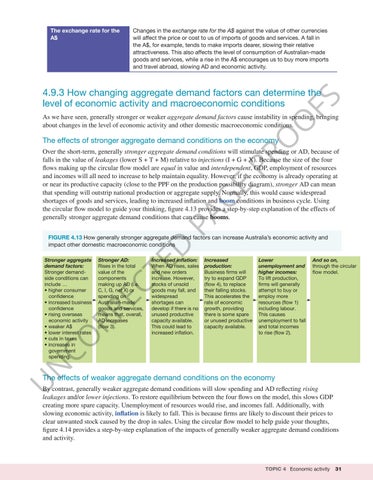“c04EconomicActivity_PrintPDF” — 2022/5/28 — 13:00 — page 31 — #31
The exchange rate for the A$
Changes in the exchange rate for the A$ against the value of other currencies will affect the price or cost to us of imports of goods and services. A fall in the A$, for example, tends to make imports dearer, slowing their relative attractiveness. This also affects the level of consumption of Australian-made goods and services, while a rise in the A$ encourages us to buy more imports and travel abroad, slowing AD and economic activity.
FS
4.9.3 How changing aggregate demand factors can determine the level of economic activity and macroeconomic conditions
O
O
As we have seen, generally stronger or weaker aggregate demand factors cause instability in spending, bringing about changes in the level of economic activity and other domestic macroeconomic conditions.
The effects of stronger aggregate demand conditions on the economy
PA
G
E
PR
Over the short-term, generally stronger aggregate demand conditions will stimulate spending or AD, because of falls in the value of leakages (lower S + T + M) relative to injections (I + G + X). Because the size of the four flows making up the circular flow model are equal in value and interdependent, GDP, employment of resources and incomes will all need to increase to help maintain equality. However, if the economy is already operating at or near its productive capacity (close to the PPF on the production possibility diagram), stronger AD can mean that spending will outstrip national production or aggregate supply. Normally, this would cause widespread shortages of goods and services, leading to increased inflation and boom conditions in business cycle. Using the circular flow model to guide your thinking, figure 4.13 provides a step-by-step explanation of the effects of generally stronger aggregate demand conditions that can cause booms.
Increased inflation: When AD rises, sales and new orders increase. However, stocks of unsold goods may fall, and widespread shortages can develop if there is no unused productive capacity available. This could lead to increased inflation.
TE
Stronger AD: Rises in the total value of the components making up AD (i.e. C, I, G, net X) or spending on Australian-made goods and services, means that, overall, AD increases (flow 3).
Increased production: Business firms will try to expand GDP (flow 4), to replace their falling stocks. This accelerates the rate of economic growth, providing there is some spare or unused productive capacity available.
Lower unemployment and higher incomes: To lift production, firms will generally attempt to buy or employ more resources (flow 1) including labour. This causes unemployment to fall and total incomes to rise (flow 2).
And so on, through the circular flow model.
N
CO RR EC
Stronger aggregate demand factors: Stronger demandside conditions can include … • higher consumer confidence • increased business confidence • rising overseas economic activity • weaker A$ • lower interest rates • cuts in taxes • increases in government spending.
D
FIGURE 4.13 How generally stronger aggregate demand factors can increase Australia’s economic activity and impact other domestic macroeconomic conditions
U
The effects of weaker aggregate demand conditions on the economy By contrast, generally weaker aggregate demand conditions will slow spending and AD reflecting rising leakages and/or lower injections. To restore equilibrium between the four flows on the model, this slows GDP creating more spare capacity. Unemployment of resources would rise, and incomes fall. Additionally, with slowing economic activity, inflation is likely to fall. This is because firms are likely to discount their prices to clear unwanted stock caused by the drop in sales. Using the circular flow model to help guide your thoughts, figure 4.14 provides a step-by-step explanation of the impacts of generally weaker aggregate demand conditions and activity.
TOPIC 4 Economic activity
31





















































